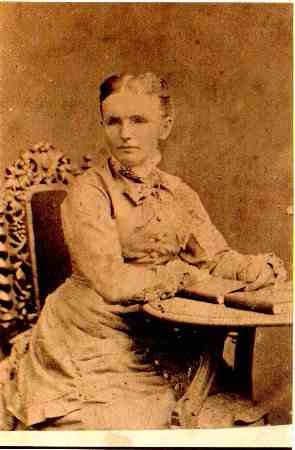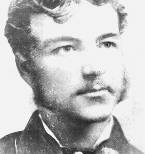| Name | Elizabeth Jane "Lilly" HUTSON |  |
| Birth | 1850, Christening: 16 JUN 1850 Saint Faith, Havant, Hampshire, England | |
| Death | 1929, Heidelberg Age: 79 | |
| Burial | Leongatha Cemetery - Baptist Section
2 Unmarked graves between Collins+Hoult & Morgan |
|
| Occupation | Nursing Midwife | |
| Father | Charles HODSON (1821-) | |
| Mother | Anne MANLEY (1826-) | |
| 1 | Married William Richardson BREDIN on the 28 Feb 1870, Havant, Hampshire. |
| Birth | About 1828 in Canada |
| Death | Accidental (fall) 8 Apr 1907 Aged 79, at Rheola, Victoria, Australia. (Chapel Gully gold field) |
| 2 | UNKNOWN |
| Children: | Myrtle (1890-1960) |
| Albert Edward (1889-1889) |
| 3 | Married Charles Henry PROSSER (SHARMAN) on 12 May 1894, 430 Bourke St, Melbourne. |
| Birth | 27 May 1860 |
| Death | 1930, Wonthaggi Hospital Age: 69 |
| Burial | Leongatha |
| Father | Charles Thomas SHARMAN (1827-1902) |
| Mother | Sarah Ann CLARK (1832-1895) |

| Children: | Harry Hutson (1895-1964) |
1911 Encyclopaedia
HAVANT, a market-town in the Fareham parliamentary division of
Hampshire, England, 67 m. SW. from London by the London & South
Western and the London, Brighton & South Coast railways. Pop. of
urban district (iooi), 3837. The urban district of Warblington, i m.
S.E. (pop. 3639), has a fine church, Norman and later, with traces of
pre-Norman work, and some remains of a Tudor castle. Havant lies in a
flat coastal district, near the head of Langstone Harbour, a wide
shallow inlet of the English Channel. The church of St Faith was
largely rebuilt in 1875, but retains some good Early English work.
There are breweries and tanneries, and the manufacture of parchment is
carried on.
Havant's parish church is dedicated to St Faith, a young girl of
Aquitaine in France, who was martyred A.D.290 during the Diocletian
persecution. Whilst unrecorded in the Doomsday Survey, there are other
references to the church about this time. The early Gothic style is
retained despite being rebuilt and restored several times.
The churchyard had always been Havant's principal burial ground and by
1850 it was estimated to hold the remains of over 20,000 souls. Its
level had risen to well above that of the surrounding streets and as it
became impossible to make new burials without disturbing the remains of
others, a new cemetery was established on land in New Lane which had
been given by Sir George Staunton. One acre was allocated for the
church and a quarter of an acre for dissenters. The cemetery was
expanded in 1896.
By 1800 there were several shops and a church house in front of the
church in West Street; most of these were demolished at some time but
one building remained at the corner of Homewell by the churchyard until
the 1920s. The church house was founded for the use of the poor and
became a meeting place for social events. Spits, crocks and other
utensils for cooking were provided by the parish free of charge and
could be obtained from here. The building was later converted into an
almshouse, the last occupants being two aged paupers by the names of
Bishop and Carpenter.
Examination of the records of the Court Leet, the manorial court which
dealt with criminal offences, gives some idea of lawlessness in the
17th and 18th Centuries. Havant possessed the usual equipment for the
punishment of offenders; the ducking stool, stocks, pillory, whipping
post and the lock up. Anyone sentenced to be confined in one of these
appliances would become the target of abuse and missiles from their
fellow townspeople.
The pastureland around Havant and on the Downs was ideal for sheep
farming which in turn supported a number of other industries. Wool was
made into cloth and a thriving trade was established. However, during
the 16th Century, Parliament introduced a new standard size to which
cloth had to be manufactured and as this could not be complied with
locally, the industry went into decline. The sheep also provided
essential food and their skins were used for the manufacture of
parchment and leather.
Havant parchment was held in very high esteem on account of its
whiteness compared with all other parchment which tended to be yellow.
It was made from the inner layer of the sheep's skin which was
processed over several weeks before being finished. Throughout
manufacture large quantities of spring water were used and it was the
unique properties of this water which were responsible for the
parchment's whiteness.
Although parchment had been made in Havant for hundreds of years there
is no evidence to show that it was produced on any large scale until
the 1850s. The last parchment yard, Stallard's in Homewell, closed in
1936.
The outer layer of the sheep's skins, together with the skins of other
animals, went to various tanneries in the town for making into leather.
This was another industry requiring a large volume of water. It
flourished by supplying boot, shoe, clothes and harness-making trades.
The making of leather and high quality gloves continued into the 1960s,
much of the latter work being carried out in employees' homes.
Brewing was another thriving local industry also reliant on the
abundant supply of virtually pure water. In 1855 there were four
breweries and nine malt houses in the town and in addition a number of
Beer Houses brewed their own supply. The barley for the malt as well as
the hops were grown locally. The last brewery was Biden's which was
situated in West Street next to the Prince of Wales. When it closed in
the 1920s it was converted into a laundry, later becoming the Home
Service Laundry, making exploitative use of the brewery's old well.
Another laundry, the steam-driven Hygeia in Waterloo Road, also had its
own well.
Havant Church is dedicated to St. Faith, the girl martyr
of Aquitaine. This dedication has existed since the eleventh century,
and there has been a church of St. Faith at Havant on this spot for
about nine centuries. Of the original Saxon, or Norman, church nothing
definitely remains, although it is probable that some of the stonework
is older material re-used.
There is let into the wall of the west end, near to the font, a
peculiarly carved stone. This was found in the rubble filling the tower
when it was rebuilt in the 19th century. The carving has been called
part of a Saxon font but it was very likely executed much later. Even
so, it is probably the earliest stone fragment in the church.
There is a possibility that some of the brick in the wall is Roman.
When the church was being repaired in 1832 it was found to be standing
on part of a Roman foundation. The Saxon church was replaced in the
12th century, when the arches of the crossing were set up, and a nave
of three bays was continued towards the west. The original height of
this nave was the same as that of the present chancel.
The chancel, the oldest undisturbed part of the building, was
constructed in the early 13th century. It was originally lit by the
lancet windows in the north and south walls of each bay, of which that
on the north-east survives. The original east window also probably
consisted of three of these lancets. North and south transepts in
similar style completed the building.
In the 14the century an extra storey was apparently added to the tower;
the lancets in the chancel were replaced, with one exception, by the
present windows. A vestry was built on the north-east bay of the
chancel, and the lancet window was buried in the new wall to be
preserved for posterity.
Later too, the triple lancet at the east end was replaced by a
perpendicular window, and the north transept aisle was added, probably
in the late 15th century, to be the chantry and tomb of Sir Richard
Dalyngridge, Lord of the Manor of Wade. The chantry lapsed before 1547.
This completed the church as it was to remain until the 19th century.
In 1832 the nave was found to be very unsafe. It was taken down and a
new one built, also of three bays, but higher than before, and without
aisles. The resulting structure was adequate but not very handsome.
Then, in about 1870, it was discovered that the removal of the nave and
its rebuilding had seriously affected the strength of the tower. This
was on the point of collapse, and in fact was only saved by the brick
supports inserted in 1832.
From then until 1875 the whole of the western end of the church was
remodelled. The tower was taken down to the level of the crossing
arches, which were strengthened and repaired, and was then rebuilt to
the old plan with the original materials. The nave was rebuilt, this
time with aisles, and was extended one bay to the west. The north porch
was added, and the south transept aisle built on the pattern of that on
the north. This resulted in the building which you see today.